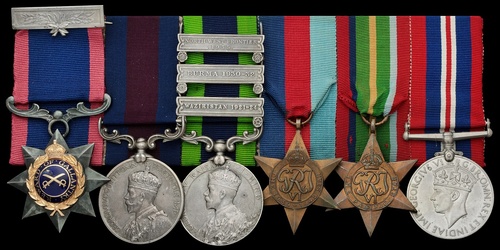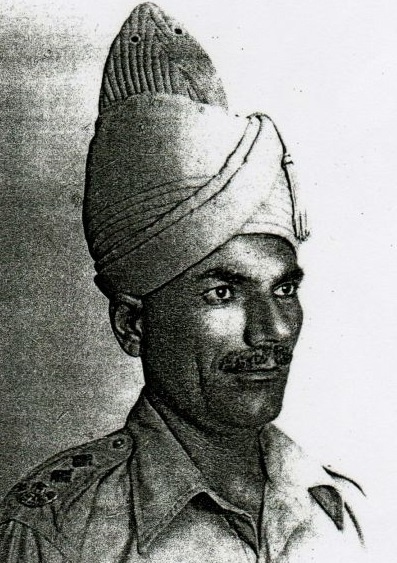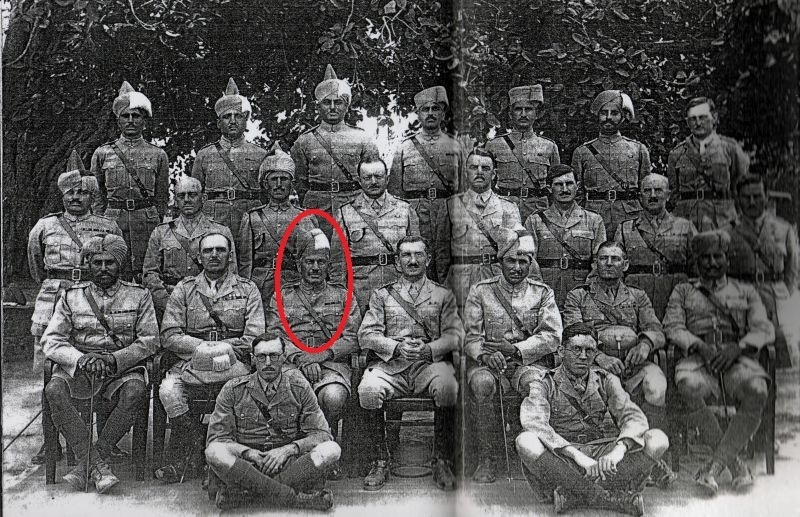Auction: 22002 - Orders, Decorations and Medals
Lot: 226
The superb and poignant 'Far East P.O.W.' posthumous Indian Order of Merit and 1935 Mohmand I.D.S.M. group of six awarded to Subedar Makhmad Anwar, 2nd Battalion, 15th Punjab Regiment, who was singled out and strung up by the Japanese in order to attempt to secure his defection to the Indian National Army - Anwar refused to yield despite savage twice-daily beatings, which resulted in maggot infested wounds, and was eventually executed
Indian Order of Merit, (1945-47 issue), 4th Type, Reward of Gallantry, silver, gold and enamel, reverse with central nut fitting, complete with top suspension brooch; Indian Distinguished Service Medal, G.VI.R. 2nd Type Crowned Head issue, with top suspension brooch (Jem. Makhmad Anwar, 2-15 Punjab R.); India General Service 1908-35, 3 clasps, Waziristan 1921-24, Burma 1930-32, North West Frontier 1935 (1336 L-Nk. Makhmad Anwar, 3-12 F.F); 1939-45 Star; Pacific Star; War Medal 1939-45, enamel chip to centre of the I.O.M. and some contact wear to the I.G.S., very fine and likely a unique combination of awards (6)
Abbott and Tamplin suggest '...as few as 35 although the position is unclear' for this issue of the I.O.M.
I.O.M. (Posthumous) London Gazette 25 September 1947. The original recommendation - by His Excellency the Commander-in-Chief - states:
'After capture by the Japanese Subedar Makhmad Anwar and other Viceroy’s Commissioned Officers were imprisoned in Kuching, where they were separated from their troops and locked in local cells. The treatment was very bad and they were beaten regularly as they refused to co-operate with the Japanese.
Subedar Makhmad Anwar, due to his seniority and persistent refusals to cooperate, received extra punishments, which in the end caused his death.
He was strung up by his feet and beaten twice daily. The wounds caused by these thrashings became septic and he finished up in such a bad state that when he died, during one of these thrashings, maggots had already infected his wounds.
The courage, fortitude and extreme devotion to duty displayed by this Viceroy’s Commissioned Officer was in keeping with the highest traditions of the Indian Army.'
Chhina states 98 such awards of the 2nd Type Crowned Head issue of the I.D.S.M.
I.D.S.M. awarded as per GGO No. 309 of 8 May 1936 for the Mohmand Operations.
Makhmad Anwar entered the Indian Army on 5 June 1918. Whilst in some editions of the Indian Army list suggest he served in Iraq before the end of the Great War, his entry date removes the possibility of any entitlement for that conflict. He also clearly is not observed wearing relevant Medal ribands in the photograph of the Officers of the 2/15th Punjab Regiment prior to the outbreak of the Second World War.
Anwar saw active service in Waziristan 1921-22, in Burma 1930-32 and on the North-West Frontier of India 1935, when he won the I.D.S.M. and was wounded. He was made Jemadar on 1 April 1930 and is listed as attached to the 10/15th Punjab Regiment from July 1936-January 1937, being returned to the 2/15th Punjab Regiment as Jemadar Adjutant in April 1938. He was made Subedar on 10 October 1939.
The campaign they shared in is covered excellently via http://www.kaiserscross.com/304501/521701.html and their story is recalled:
'The 2nd Battalion of the 15th Punjab Regiment was a ‘class company’ battalion with one company each of Sikhs (‘A’ Company), Punjabi Musalmans (‘B’ Company), Khattacks (‘C’ Company) and Jats (‘D’ Company). The Battalion had come from Poona to Singapore as part of 6th Indian Infantry Brigade. In Singapore the Battalion worked on defence duties and counter-invasion measures until December 1940 when one company was tasked to go to Sarawak. ‘C’ Company, commanded by Major C.A.L. Davis, was selected and Davis, with 2nd Lieutenant J.E.S. Temple and 98 men, sailed to Miri whilst Lieutenant J.H.C. Brown and 52 men went to Kuching.
...In May 1941 Lieutenant-Colonel C.M. Lane MC brought the remainder of the Punjabis to Kuching and intensive reconnaissance of the Kuching area commenced; Colonel Lane being appointed Officer Commanding Troops Sarawak and Brunei. The training of the Sarawak State Forces was speeded up and Punjabi gun detachments were trained to man three elderly 18-pounder guns that were issued to the Battalion. As the Battalion had first-line and second-line reinforcements with it, plus an attached platoon of Jats from the 4/15th Punjabis, the Battalion strength was 1,075 all ranks. When the state forces of Sarawak and Brunei were added Sarfor numbered 2,565 all ranks.
...When war with Japan was declared on 8th December 1941, 2/15th Punjabis was commanded by Lieutenant-Colonel G. Ross-Thompson, Colonel Lane being the Commander of Sarfor. Major F.G. Milligan was the Sarfor staff officer, and Captain J.E.S. Temple was the Battalion Adjutant. Captain Mohd. Mataul Mulk, brother of the Prince of Chitral, was Liaison Officer to the local state forces. The Battalion contained fourteen or fifteen British officers, about half of them being attached from the Sarawak State Forces, and twenty Indian officers.
...The war arrived at Kuching on 19th December when sixteen Japanese bombers raided the town and the airfield, killing 25 civilians and wounding around 80 others whilst setting a petrol dump alight and causing other damage. Allied aircraft did not intervene. Four days later a Japanese naval convoy arrived off the coast, and Singapore ordered the immediate destruction of Kuching airfield. The sappers destroyed the airstrip and the direction-finding equipment that night, using 50 boreholes that had been drilled across the strip in preparation.
A Japanese force had sailed from Camranh Bay in French Indo-China and consisted of the Japanese 35th Infantry Brigade Headquarters and 124th Infantry Regiment augmented by the Yokosuka 2nd Special Naval Landing Force. The Japanese first landed at Miri and left one battalion to occupy North Borneo, Brunei and Labuan Island before sailing to Kuching. Japanese aircraft supplied vital support to the force by bombing the Dutch Singkawang II airfield that lay west of Kuching: the bombing of the runway prevented Dutch planes from taking off to attack the Japanese ships, and later that day the Dutch were authorised to remove their planes to Palembang in Sumatra. However two Dutch submarines engaged the enemy ships, sinking two and damaging two others; a Japanese submarine then stalked one of its Dutch adversaries and sank it. Five British Blenheim aircraft from Singapore, operating at almost the limit of their range, attacked the Japanese ships but did little damage.
The following morning, 24th December, twenty enemy landing craft approached the mouths of the Santubong and Muara Tebas rivers that led to Kuching. First to engage the Japanese were the Sarawak Coastal Marine Service and the Sarawak Rangers, firing from the swamps. A Punjab Regiment gunboat platoon, firing anti-tank rifles from its small craft, went into action for two hours but then moved up-river when it was out-gunned. As the landing craft approached Kuching the Punjabis’ 18-pounder guns started scoring hits, supported by a 3-inch mortar detachment. Seven craft were sunk before the Japanese landed and overran the gun and mortar positions, seizing one gun before it could be withdrawn. Colonel Lane had been given Percival’s permission to withdraw after holding up the invasion for as long as possible, and fighting between Captain P.Y. Fairburn’s Sikh ‘A’ Company and the invaders continued until 16.30 hours when Kuching was in Japanese hands. To save the civilian population Kuching had been declared an ‘open city’ and there were no British defence activities within the town. ‘A’ Company then withdrew to join the Battalion at the airfield. On the way a platoon of ‘A’ Company under 2nd Lieutenant J.H. Farwell, having already been dive-bombed, was badly ambushed at the Kuching suspension bridge by an enemy group wearing Sarawak Constabulary uniforms. Those of the platoon not killed were captured including John Farwell. The Japanese wasted no time in deploying and by nightfall they were testing the airfield perimeter defences; these probes continued throughout the night.
Next day, Christmas morning, after unsuccessfully requesting orders from Singapore Colonel Lane ordered a withdrawal into Dutch Borneo. A group of British women and children along with the hospital detachment were sent ahead during a lull in the firing, and ‘A’ Company went to secure the vital ferry crossing at Batu Kitak. As these movements were proceeding a large Japanese force attacked the 2/15th Punjabis rear-guard in strength.
After a stiff fight, particularly by the Khattacks who machine-gunned a considerable number of advancing Japanese, four British officers, six Indian Officers and 230 Sepoys were killed or taken prisoner, wounded prisoners being bayoneted by the Japanese. Captain J.H.C. ‘Bruno’ Brown, OC ‘B’ Company, was amongst the dead having killed two Japanese with his revolver before a third bayoneted him. Lieutenant D.A. ‘Doggy’ Hodges, OC ‘C’ Company, was amongst the prisoners, having surrendered his company when it was surrounded and only two platoons were still able to fight. Only a few sepoys trickled back to re-join the Battalion. The Japanese casualty list for this rear-guard action was believed to have included 374 men killed, including the formation commander.'
As their movements took them onto Sanggau, they would stand firm to the last:
'Captain Fairburn’s Sikh ‘A’ Company put in an attack that seized the first enemy trenches but which ultimately failed when the planned Dutch flanking movement fell apart in a Japanese ambush that killed the Dutch commander. Badly-sited and poorly-controlled Dutch heavy mortars wounded Dutch soldiers and Punjabis alike and killed Subedar Kartar Singh. The son of Kartar Singh was serving in the Battalion and he performed his father’s funeral rites.
During the next day the Japanese tried to break through to Singkawang II airfield. Their progress was blocked by Subedar Faramurz Khan and two platoons of Punjabi Musalmans from ‘B’ Company. Faramurz Khan exhorted his men to fight to the end. After an all-day action the Punjabis were finally overrun in the early evening, having expended their ammunition. Faramurz Khan and many of his men were already dead but the Japanese were angry and vengeful because of the 400 or more casualties that they themselves had suffered. Only three Punjabis from these two platoons were seen again, and one of them, Lance-Naik Sher Khan, later reported that the Japanese wired together the prisoners taken, doused them in petrol and burned them to death.'
Having continued the Battle for as long as possible, concerned about the physical condition of the men Colonel Lane and Lieutenant-Colonel Ross-Thompson decided that further resistance would be futile and Sarfor surrendered to a Japanese Naval Brigade on 3 April 1942. Further note should be given to the dreadful conditions and privations forced upon Anwar after he was captured with his comrades:
'In captivity Sarfor was split up and placed in several camps in South-East Asia. All the British officers of the 2/15th Punjab Regiment survived captivity. Some were held in the Batu Lintang camp, Kuching, and mention is made of them in Don Wall’s book Kill the Prisoners. It was the Indian officers and soldiers who suffered the most from Japanese atrocities in the camps. Most men, led by their Indian officers, refused to join the Japanese-sponsored Indian National Army led by the collaborator Subhas Chandra Bose. This infuriated the Japanese, and in the Kuala Belait camp in Brunei Subedar Makhmad Anwar I.D.S.M. was flogged and hung by his heels until he was dead. Four jemadars in Kuala Belait camp (Akram Khan, Mohamed Anwar, Nazir Hussain and Lachman Singh) were made to dig their own graves before they were beheaded. It appears that fifty sepoys who had refused to collaborate were tied up and bayoneted or otherwise murdered.
One personal account of a sepoy in captivity can be found in Mark Felton’s The Final Betrayal. Mountbatten, MacArthur and the Tragedy of Japanese POWs. Naik Changdi Ram, 2/15th Punjabis, gave formal evidence after his release from captivity by Australian troops; the evidence records beatings, tortures and acts of cannibalism by Japanese soldiers performed on Allied European and Indian troops.'
David H. James in The Rise and Fall of the Japanese Empire explored the gallantry of Anwar further, after he refused to join the Japanese-sponsored Indian National Army:
'Then, what was left of the detachment were rounded up in Kuala Belait. The leaders of the resistance - Sub. Makhmad Anwar, Jemadars Mohd Anwar, Mohad Akram, Nazir Hussain and Lachman Singh - were placed in solitary confinement.
On 21st April 1945, Makhmad Anwar - still refusing to obey - was taken from his cell, strung up by his feet, head swinging clear of the ground was slowly beaten to death. Slowly beaten to death! His festering wounds, caused by the brutality, were septic and maggot infested - but he refused to be a traitor.'
Similar bravery was shown by scores of their countrymen and in all just 30,000 Prisoners defected to the I.N.A. - the last words of Subadar Framurz Khan are fitting:
'We are dying, but dying after doing duty to God, King and Country and to die such a death is the most sacred one of all.'
James singled out Anwar, Framurz and Kartar Singh as those whose ultimate sacrifice ensured the loyalty of the Indian troops who served in the British Indian Army under the most testing conditions.
Anwar is commemorated upon the Singapore Memorial; sold together with copied research which includes images of the recipient.
For the M.M. awarded to a Battalion comrade, please see Lot 225.
Subject to 20% VAT on Buyer’s Premium. For more information please view Terms and Conditions for Buyers.
Sold for
£21,000
Starting price
£6500
Sale 22002 Notices
'In group photograph, Anwar is seated front row, third from RIGHT, not front row, third from left.'









